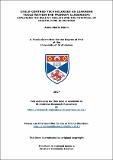Files in this item
Child-centred technologies as learning tools within the primary classroom : exploring the role of tablets and the potential of digital pens in schools
Item metadata
| dc.contributor.advisor | Quigley, Aaron John | |
| dc.contributor.author | Mann, Anne-Marie | |
| dc.coverage.spatial | ix, 331 p. | en_US |
| dc.date.accessioned | 2017-06-16T15:25:24Z | |
| dc.date.available | 2017-06-16T15:25:24Z | |
| dc.date.issued | 2017-06-21 | |
| dc.identifier.uri | https://hdl.handle.net/10023/11012 | |
| dc.description.abstract | This thesis provides insights into how technology can be and is used as child-centric learning tools within primary school classrooms. The conducted studies look closely at how tablet technology is integrated into the modern classroom, and considers how existing digital writing technologies could support handwriting-based learning exercises in future. This is achieved by conducting three in-the-wild studies, using different approaches, with a total of seventy-four children in school classrooms. In the first study, focus is placed on how tablets integrate into and with existing classroom practices, documenting when and how children use tablets in class. Relevant and complementary to this, the use of traditional writing tools is questioned and two further studies explore the potential and suitability of digital pens to support children’s handwriting-based learning. One looks in detail at how children’s handwriting is effected by different existing digital pen technologies. The other study, conducted through a creative, participatory design session, asks children to provide their opinions regarding desirable features for digital writing technology. The findings from this research classify and exemplify the role of tablets in the classroom, and explore potential design directions of digital writing tools which could be used by children in the future. This work may be useful and of interest to others who conduct research with children within the fields of Human Computer Interaction, Child Computer Interaction or education. | en_US |
| dc.language.iso | en | en_US |
| dc.publisher | University of St Andrews | |
| dc.rights | Attribution-ShareAlike 4.0 International | * |
| dc.rights.uri | http://creativecommons.org/licenses/by-sa/4.0/ | * |
| dc.subject | HCI | en_US |
| dc.subject | Children | en_US |
| dc.subject | Participatory design | en_US |
| dc.subject | Tablet technology | en_US |
| dc.subject | School | en_US |
| dc.subject | Digital pens | en_US |
| dc.subject | Learning using technology | en_US |
| dc.subject | Classroom | en_US |
| dc.subject | In-the-wild studies | en_US |
| dc.subject | Handwriting | en_US |
| dc.subject | CCI | en_US |
| dc.subject.lcc | QA76.9H85M26 | |
| dc.subject.lcsh | Human-computer interaction | en |
| dc.subject.lcsh | Technology and children | en |
| dc.subject.lcsh | Tablet computers--Study and teaching (Primary) | en |
| dc.subject.lcsh | Penmanship--Study and teaching (Primary)--Technological innovations | en |
| dc.title | Child-centred technologies as learning tools within the primary classroom : exploring the role of tablets and the potential of digital pens in schools | en_US |
| dc.type | Thesis | en_US |
| dc.contributor.sponsor | Engineering and Physical Sciences Research Council (EPSRC) | en_US |
| dc.type.qualificationlevel | Doctoral | en_US |
| dc.type.qualificationname | PhD Doctor of Philosophy | en_US |
| dc.publisher.institution | The University of St Andrews | en_US |
The following licence files are associated with this item:
This item appears in the following Collection(s)
Except where otherwise noted within the work, this item's licence for re-use is described as Attribution-ShareAlike 4.0 International
Items in the St Andrews Research Repository are protected by copyright, with all rights reserved, unless otherwise indicated.


